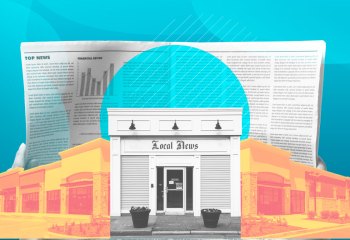
Report for America: What We’ve Learned So Far
The appetite for a “public service” approach is strong but the on-the-ground challenges in newsrooms are real
Report for America has grown rapidly. The program—which places emerging journalists into local newsrooms to report on under-covered issues and communities—went from 13 corps members in 2018-19, to 59 in 2019-20 to 250 in 2020-21 (starting in June).
We’re expanding that fast because the size of the crisis demands it. But that means we will be making plenty of mistakes along the way, and have to constantly learn and reassess. Here are some of our key lessons learned after three years of running the program.
The passion to cover local news is intense.
We just closed our application window for journalists and can now announce the results (drum roll): a 95 percent increase in submissions over last year! We had more than 1,800 applicants for about 200 open slots.
Another indicator: About 90 percent of the current corps members renewed for a second year. And about half our current group of newsrooms have also requested additional reporters.
In short, there is a massive demand among young journalists to be local public service reporters. We’ve known for a while that journalism schools were oversubscribed but it’s notable that emerging journalists have specifically embraced the idea that the crisis in local journalism is a crisis for democracy. This isn’t about joining the resistance; it’s about serving communities.
Yes, to some extent it shows the shortage of available journalism jobs. But something else is happening. These are young journalists who rather than gravitating to glitzy jobs in New York or Washington, want to go out into local communities. The gauzier message—that local reporting isn’t just an important job, it’s a public service—is resonating.
The median age of our corps is 26. So the dominant type is not a college senior (a la Teach for America) but rather someone with a few years of professional experience. This is a good thing because the point of the program is to create great journalism, not (primarily) just to train new journalists. Yes, it creates challenges. Older journalists need to be trained differently (more intermediate and specialized training). They understand the value of good editing and so bristle when they don’t get it. They may be less patient with the low pay; but they’re not so old that their idealism has been ground out of them.
This also forced us to adapt in another way. We did not want the presence of all these somewhat experienced emerging reporters to wipe out the chances for the amazing reporters just graduating from school. So we created an informal second track – weekly newspapers, small dailies, small radio stations. These are organizations that can well use superstar recent grads and give the reporters valuable experience. The work that these reporters are doing is phenomenal and the news organizations seem thrilled too. Of course we look for the smaller news organizations that are nonetheless a primary or crucial source of journalism in their area.
In news deserts, even a little water can have a big impact.
In the second year of Report for America (RFA), there was an average of 200+ percent increase in the number of stories in the identified issue and coverage gaps. This year’s class of 59 reporters produced 1,000 stories in just their first three months. Some have had dramatic impact. Last July, Report for America corps member Obed Manuel reported for the Dallas Morning News that Francisco Erwin Galicia — an American citizen born in Dallas — had been detained by Border Patrol for three weeks without clear cause. His family feared that he’d be deported. The story went viral and Obed was interviewed on CNN. The next day, Galicia was released from ICE custody.
Samantha Hogan’s investigation for Pine Tree Watch uncovered sweeping errors in the financial oversight of the Maine Commission on Indigent Legal Services. Multiple state investigations have been launched as Maine considers a public defender system.
In August, Zak Podmore, an RFA corps member with the Salt Lake Tribune, got taxpayers in San Juan County, the poorest in Utah, a $109,500 refund after discovering that a law firm had overcharged and double billed for legal work related to the Bear Ears Park. That one story, in other words, generated for taxpayers an amount more than twice Podmore’s annual salary.
We’ve inadvertently created a third model: commercial body with nonprofit prosthetics.
The philanthropic world tends to imagine there being two models: the (noble but dying) commercial model and the (rising but fragile) nonprofit model.
But we’re also seeing the evolution of a third model—a commercial organization incorporating nonprofit elements. Chris Fusco, the managing editor of the Chicago Sun-Times, was asked how he decided to deploy his two Report for America reporters, Carlos Ballesteros and Manny Ramos. He said he’d like to be able to put Carlos and Manny on the latest local crime story, the latest shooting—but he promised Report for America he wouldn’t. The terms of their acceptance into the Report for America program—a nonprofit program backed by philanthropy—was that the reporters would focus on non-crime stories in the South and West Sides of Chicago.
So Report for America had, in effect, erected guard rails around the beats of Manny and Carlos. I suspect Chris was complaining about this with a twinkle in his eye—a sort of “throw me in the briar patch” plea. He is a great editor who understands full well the need for this kind of journalism.
In addition, the presence of Report for America has forced, encouraged and helped the commercial entities to develop muscles that they should be building anyway. We make them define and measure the biggest coverage gaps in the community—and then measure the impact (or not) of the reporter. We make them attempt to raise money from either local foundations or the community, through small donations. I think of it as injecting vitamins into the bloodstream. The hope is that the benefits are pervasive and ultimately energize the whole body.
Local philanthropists (of all giving levels) are beginning to see local journalism as community service and a public good.
Local philanthropy is starting to come off the sidelines. Report for America encourages local news organizations to raise part of their share of the cost for a reporter from local donors, large and/or small.
We will be announcing our 2019 results at the Knight Media Forum but here’s the sneak peak: Scores of newsrooms have raised local philanthropic dollars for their Report for America positions, including some who have never raised such funds before.
We’re just getting started in earnest on this part of the program. We hired Todd Franko, the former editor of The Vindicator in Youngstown, Ohio, to be the Director of Local Sustainability.
The Salt Lake Tribune conducted a successful crowdfunding program, raising almost $52,000 to support two Report for America corps members. This funding came from many $10 to $100 individual donations. The goal was to raise $40,000. The Blue Grass Community Foundation is covering the local share for the Lexington Herald-Leader’s corps member Alex Acquisto, who is reporting on public health.
What our outreach is showing is that news organizations are finding fundraising success when they actively engage their local funder community with best practices. In many of the fundraising successes, it’s a new activity for the newsroom and the local donor community. They are not companies and communities used to this practice.
The service project may turn out to be a more impactful element of Report for America than we originally expected.
We require corps members to do a community service project, such as working with local high schools to launch or enhance a school newspaper. We did this originally because we wanted to underline the idea that local journalism is a public service. We thought it was a good way to teach media literacy, and we thought it would be a way for the reporter to get into the community that would help them build trust.
But we’re seeing more benefits than expected. First, it’s really stimulating activity on the high school and middle school level. The service projects range from restarting a defunct high school newspaper in Dallas, to launching an interview-style student podcast in Wisconsin, to helping the children of migrant workers in eastern Oregon create a bilingual newsletter for their parents.
The corps members themselves learn from the students. “My students have painted a different picture of this place, one that adults rarely talk about, at least not in explicit terms,” corps member Samantha Max wrote in a piece for USA Today about teaching students in Macon, Ga., how to make a podcast. “One week, a student told the class that he struggles to balance his schoolwork and late-night shifts at Burger King. Another shared that he had been kicked out of his first elementary school when he was 6 years old for bringing his older brother’s BB gun to school.”
The corps members aren’t required to work with students, but most do. This year’s projects are serving more than 700 students. And imagine the impact as Report for America scales. When we have 1,000 reporters, in four years, we will be working with something like 14,000 students per year.
The challenges facing local news organizations are deeper and more multifaceted than we expected.
We all understand that local news organizations have too few people. But we didn’t fully understand how this reality ripples through communities.
First, the erosion of reporting has been joined by a crisis in editing. The most common problem we see in news organizations is that reporters don’t get sufficient editing. This will eventually make local journalism shallower and sloppier.
Second, it’s not just that there are too few reporters; it’s that the commercial news organizations are often in a perpetual state of downsizing. Each time the patient stabilizes, it’s time for a new blood-letting, which can undermine confidence in the news organization’s future and jeopardize its hold on talented reporters and editors. Meanwhile, nonprofit news outlets are growing but often still frail.
Third, beats have eroded. Typically, when news organizations get smaller, they either move to more general assignment reporters or they stack beats. The person who used to cover higher education now covers education and health. The more that beats are stacked, the less opportunity there is for depth, source-building and trust building. This has prompted us to be more insistent that Report for America reporters are doing well-defined and reasonably sized beats.
Fourth, there’s a wisdom-drain. We all know that too many news organizations lay off or push out (through buyouts) the more experienced reporters because they’re more expensive. That’s its own tragedy. The wisdom that these reporters built up, about topics and craft, is one of the most important elements of value in the enterprise. We are attempting to partly address this with our new mentoring program with 58 journalists supporting our Report for America corps members.
Diversity is hard work—but we’re finding success.
We’re exceedingly proud of our record so far on diversity. Almost 40 percent of the corps members are journalists of color. If we are able to maintain roughly that ratio in the 2020 class, that will mean 100 new journalists of color working in the field, a significant movement.
But we have a long way to go. We need to be more sensitive to the unique issues presented to diverse reporters who might be the only African American or Latinx in their news organization. And we’re hearing an alarming rumble: The collapse of high school journalism opportunities may be drying up the pipeline of talented diverse journalists. Efforts to improve diversity need to start earlier.
Many Report for America slots cover communities of color, and a third of newsrooms asked for reporters who speak Spanish. We have also made a major commitment to covering Native American affairs—with 19 reporting positions focused on that topic.
We’ve learned a lot, and have a lot to learn. But all in all, the lessons have given us more hope, not less for the future of local news.
Steven Waldman is co-founder and President of Report for America, which is an initiative of The GroundTruth Project.
You many also be interested…
Recent Content
-
Journalismarticle ·
-
Journalismarticle ·
-
Journalismarticle ·





